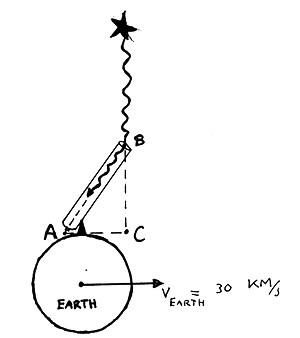 Figure 2-2-I
Bradley's explanation of stellar aberration. But you can also say: take B to be the moment that the light wave moves out of the gravity field of the Sun and into the gravity field of the Earth. Then the direction of the light wave (the line from the star to B) may change in B because the light wave “crashes” with 300,000 km/s into the Earth's gravity field that is moving with 30 km/s (on the dotted line AC) to the right (in Fig. 2-2-I). And so, because of this what I call crash in effect, perhaps the light does go from B to A and not from B to C as scientists think since 1727.
[February 2004: The light than does go from B to A for an observer in the gravity field of the Earth (= us); but it goes from B to C for an observer in the gravity field of the Sun (perhaps not entirely, see also Fig. 2-2-III). End February 2004] Another explanation of stellar aberration than the crash in effect may be double drag.
The boundary between the gravity field of the Earth and the Sun may have an area where a photon is influenced by the gravity field of the Sun as well as the gravity field of the Earth (see Fig. 2-2-II). In this double drag area the gravity field of the Sun tries to keep the light wave in the same “track”, so there may be a gravity force of the Sun (FGrav. Sun) pulling on the light in the opposite direction than the direction of the Earth('s gravity field). (The crash in effect and the double drag effect may be the same, see 3-1.) 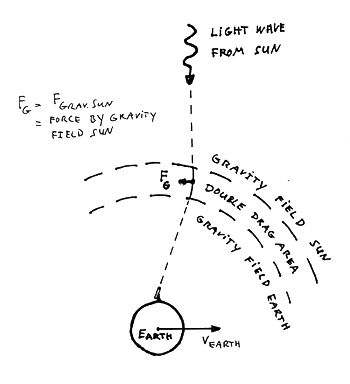 Figure 2-2-II
A light wave may travel from the gravity field of the Sun to the gravity field of the Earth via a double drag area where the light wave is under influence of the gravity field of the Sun as well as the gravity field of the Earth and hence aberration may be caused. [March 25 2005: Of course, the crash in effect is the double drag effect. What I called crash in effect did not give any reason for stellar aberration. With double drag it is different. You may see it as the combination of two forces like: a raindrop falling down to Earth by gravity while being blown by the wind and so the path of the raindrop to the Earth is tilted. With a photon the path only gets tilted in the double drag area, but after the double drag area the photon follows its path in the new direction (within the gravity field of the Earth and without (or at least almost without) gravitational forces by the Sun), i.e. there does not have to be a force all the time as with a raindrop to keep the photonpath tilted. End March 25 2005]
[April 22 2005: The following concerning the above mentioned reasoning about stellar aberration may make the reasoning a bit easier to understand. Imagine two tables (tables 1 and 2) next to each other and seen from above. The tables are very long (see Fig. 2-2-II-a). Table 2 is moving from left to right while table 1 stands still. On table 1 a massive iron ball slowly rolls towards table 2. The moment the ball rolls from table 1 on table 2 there may be two forces working on the ball (imagine the line/boundary between the tables in Fig. 2-2-II-a to be, in a way, the double drag area of Fig. 2-2-II): table 1 still has an effect on the ball trying to keep the ball going in the same direction while table 2 tries to take the ball to the right. 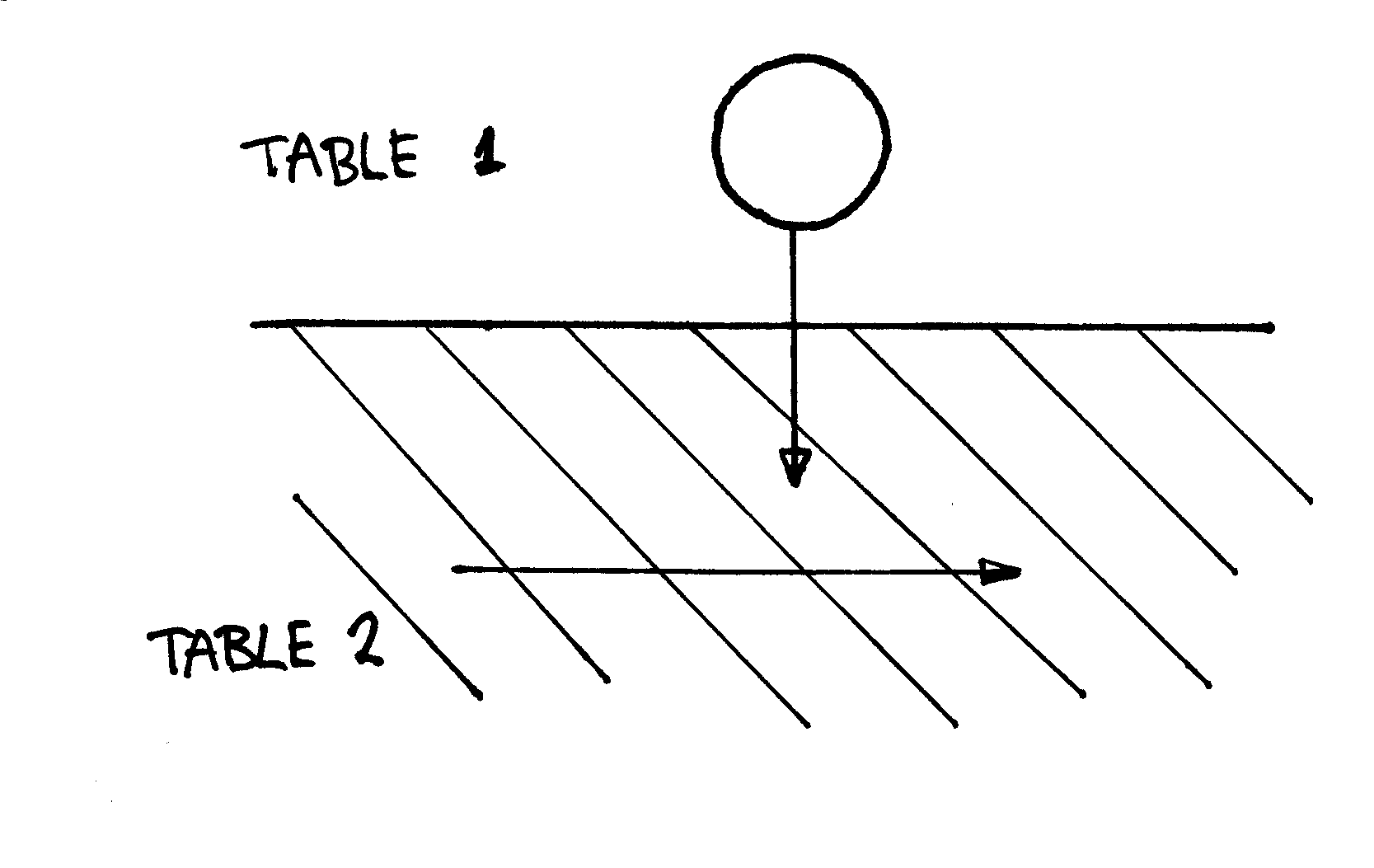 Figure 2-2-II-a
Two tables, one moving to the right, one standing still, seen from above with an iron ball rolling over. The end result may be that the ball changes its direction (as with stellar aberration of a photon) as shown in Fig. 2-2-II-b. And: the faster the speed of the moving table the bigger the aberration of the ball. I think a photon may change its direction because of two forces working on the photon in, what I call, a double drag area.
[May 20 2005: Though, there is also the inertial force of the rolling ball, as well as there must be a (inertial) force that makes a photon have its speed. So in the case of the iron ball there is an inertial force that makes the ball keep on going on in the same "track", while at the same time friction between table 2 and the ball makes the ball move more and more to the right. In the case of a photon entering the ether field of the Earth there may be a (inertial) force too that makes the photon hold to its original path for a while and then this (too) may explain stellar aberration. Also if a photon is not a particle but a wave in the ether then I think there is still a force that makes the photon/wave “wanting” (by an inertial force) to stay in the same track, while a force attached to the Earth makes the photon go to the right; I think then too the net effect of these two forces may be stellar aberration. End May 20 2005] 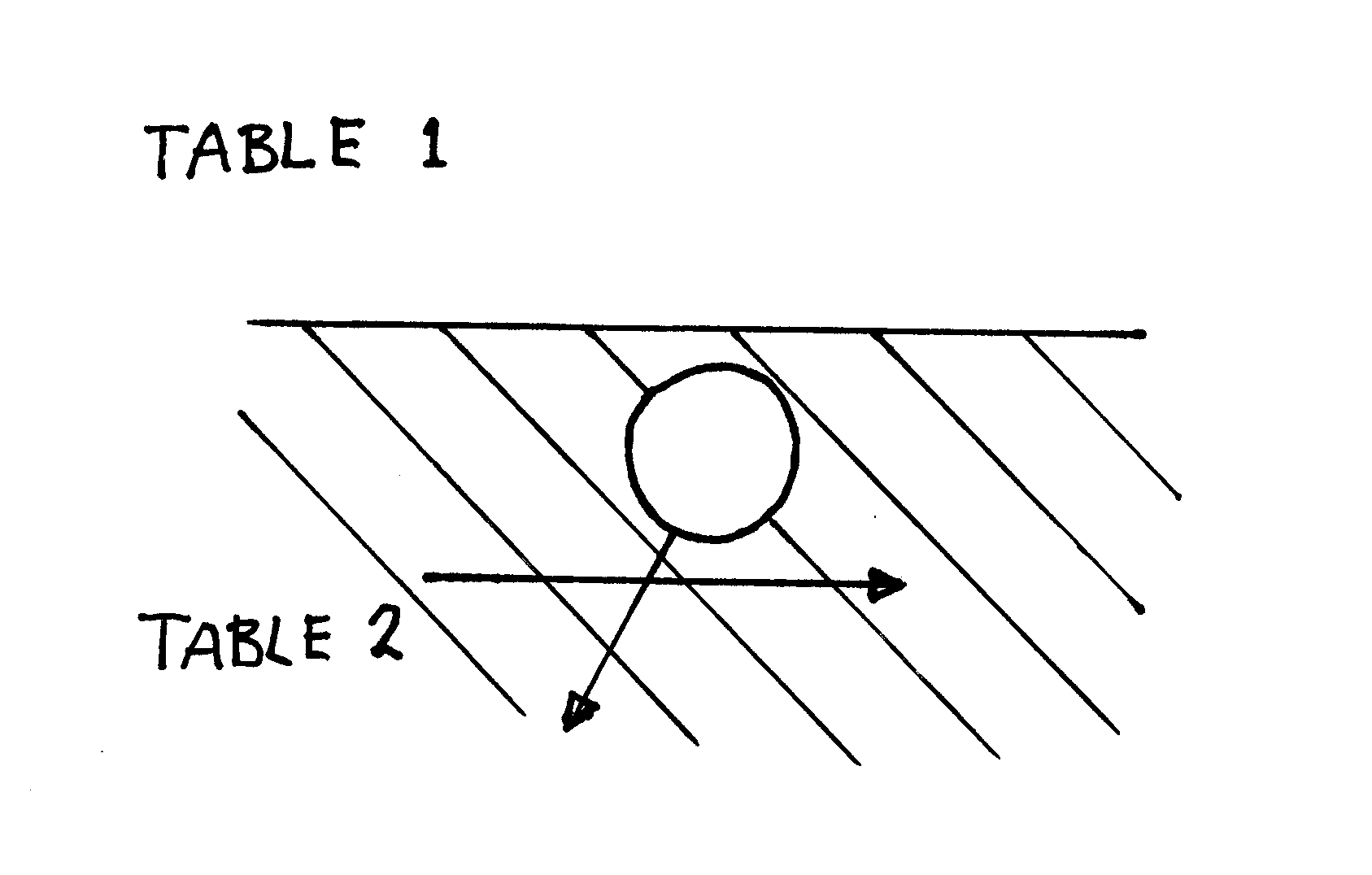 Figure 2-2-II-b
Two tables, one moving to the right, one standing still, seen from above with an iron ball rolling over. How is the in Fig. 2-2-II mentioned force of the gravity field of the Sun to be seen? Perhaps as an inertial force. Imagine that a photon has to act according to Newton's first law (3-2). In that case the photon is “pushed” forward by an inertial force (by the gravity field of the Sun) in the double drag area; an inertial force caused by (many) smaller (gravity or other) particles than the photon (with the photon seen as a particle). The moment the photon enters the gravity field of the Earth as mentioned in Fig. 2-2-III it has to adapt itself to the gravity field of the Earth and it experiences a pull to the right by the Earth in Fig. 2-2-III for someone standing on the Sun (take notice that the stellar aberration effect has been left out in the figure below). But for someone standing on the Earth the photon experiences a pull to the left by the Sun, the photon changes its direction resulting in stellar aberration for someone on Earth as mentioned in Fig. 2-2-II. As mentioned below: it remains to be seen how much the aberration effect compensates the Earth-dragging-the-light effect, an observer on the Sun may see nothing happen to the photon, i.e. in the case that the stellar aberration effect compensates exactly the Earth-dragging-the-light effect then the observer on the Sun just sees no effect at all (of course you have to imagine that an observer on the Sun can observe the photon by smaller much-faster-than-light particles coming from the photon). And when the stellar aberration effect compensates exactly the Earth-dragging-the-light effect then for someone on Earth also nothing changes in Fig. 2-2-II when the person could see the photon from far away. (In a way Fig. 2-2-II is misleading. The dotted line from the drawn photon to FGravity Sun is the path of the photon seen by an observer on the Sun and the dotted line from FGravity Sun to the drawn telescope is the path of the photon seen by an observer on the Earth.)
An inertial force working on the photon may also explain the “30 km/s energy” of the Doppler effect mentioned in 2-2. End April 22 2005] [May 23 2005: Thinking about inertial forces with respect to photons is a tricky thing. It is something that, of course, right now can only be guessed about. There may be gravity particles/waves that are used by photons to propagate itself (as a particle like a bullet, or as a wave in the ether like sound in the air or water). But there also may be a class smaller particles/waves or even another smaller class of particles/waves (or even another smaller... etc.) that make photons do/are what they do/are.
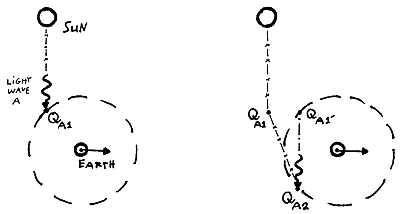   Figure 2-2-III
Light wave A is dragged along with the gravity field of the Earth when light wave A goes from QA1 (where it enters the gravity field of the Earth) to QA2 (where it re-enters the gravity field of the Sun). Of course the angle of bending is drawn out of proportion, being: [30 km/s / 300,000 km/s] x 900. The stellar aberration effect has been left out in this figure; there is aberration effect in QA1 as well as in QA2 (reverse in QA2), so the overall bending (dragging effect + stellar aberration) in QA1 as well as in QA2 may be very little for an observer in the gravity field of the Sun. There are also effects because of the Earth dragging the light wave (see Fig. 2-2-III and read its text). Thus the gravity field of the Moon may act like a lens (see Fig. 2-2-IVa).
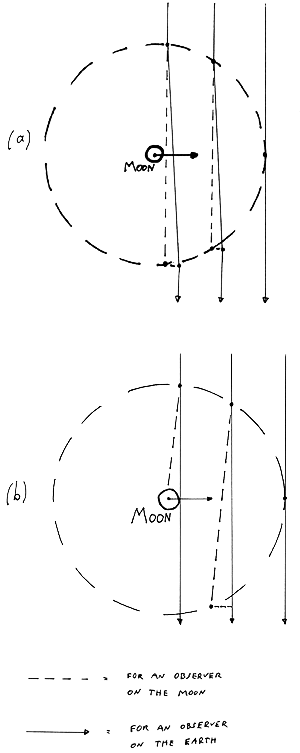 Figure 2-2-IV
Fig. 2-2-IVa: When a star is occulted by the Moon the gravity field of the Moon may act as a lens for an observer on Earth (the stellar aberration effect is left out in IVa). Fig. 2-2-IVb: The Moon-dragging-the-light plus the stellar aberration in the case the stellar aberration effect compensates exactly the Moon-dragging-the-light effect (and hence no lens effect for an observer on Earth in IVb). It remains to be seen how much the aberration effect compensates the Moon-dragging-the-light effect: Fig. 2-2-IVb shows what happens if the aberration effect compensates the Moon-dragging the-light effect to the maximum degree (of course, though unlikely to me, there is also the possibility that the aberration effect overcompensates the Moon-dragging-the-light effect, i.e. the aberration effect is bigger than the Moon-dragging-the-light effect).
It is measured that as the limb of the Moon cuts in front of a star (Fig. 2-2-Va), a diffraction pattern (Fig. 2-2-Vb) appears before the light is completely cut out8. Thus angular diameters of large nearby stars can be measured, because waves from different parts of a star (with a certain angular diameter) produce a characteristic interference pattern8. This may be a gravity is the ether effect due to light waves coming from different parts of the star that interfere because the gravity field of the Moon acts as a lens for an observer on Earth (i.e. if stellar aberration does not compensate the Moon-dragging the-light effect to the maximum degree as in Fig. 2-2-IVb). Because the path-length of the starlight going through the gravity field of the Moon (AB in Fig. 2-2-Va) becomes longer when the Moon cuts in front of the star there may be peaks and valleys in the flux due to waves of different parts of the star being in-phase and out-of-phase.  Figure 2-2-V
Occultation of a star by the Moon. As the limb of the Moon cuts in front of the star, a diffraction pattern appears before the light is completely cut out (the dotted circle is the boundary of the Moon's gravity field). From flux-measurements as in Fig. 2-2-Vb one may be able to say something too (next to the angular diameter of the star) about the magnitude of the gravity field of the Moon.
Of course, it remains to be seen whether the interference pattern isn't due to bending of the light by the Moon's gravity instead of by the Moon-dragging-the-light. The interference pattern may be caused by a combination of bending (by gravity) and dragging (by gravity/ether) as well. [May 2003: So far I had an awkward feeling about the short time of the diffraction pattern in Fig. 2-2-V: only a few hundred meters above the Moon's surface the interference pattern starts. Perhaps the magnitude of the Moon's gravity field is much less than I expected as well as the magnitude of the Earth's gravity field may be much less then I expected, i.e. much less than the Earth's gravity field as described and pictured in 2-1. I have started thinking this way after I found out that:
In Fig. 2-2-V (the property of) a gravity field in relation to a photon is mentioned. The dominance-magnitude of a gravity field (i.e. a certain area around, for instance, the Moon), where the Moon has the “strongest grip” on a certain object (like a photon, atom or meteorite) may depend on the kind of object (photon, atom or meteorite) that one deals with, for the density of the object (photon, atom or meteorite) may be very important in this respect, see 3-2. End May 2003] If the light in Fig. 2-2-I would go from B to C while the telescope moves from A to C then the same effect ought to be measured if we look at a star as in Fig. 2-2-VI. If we take the same telescope with the same focus 6 months later (with the Earth moving away from the star with 30 km/s) and look at the same star again the star should be out of focus if Bradley's explanation of stellar aberration were correct. This so-called out of focus effect has been looked for but has never been found10. With gravity is the ether we can understand why.
 Figure 2-2-VI
Measuring the out of focus effect. Another confirmation of the gravity is the ether hypothesis is the Doppler effect.
Light wave A in Fig. 2-1-I blueshifts in point QA because it diminishes its velocity with 30 km/s. The light wave has to do something with the energy of 30 km/s in order to maintain the same total amount of energy and it may do so by blueshifting. (If you imagine yourself as person A in Fig. 2-1-II: you would feel how your step “shortens” by the plate that is moving towards you and that you have to make some kind of effort (= energy response) with your body to keep walking the same tempo.) In a similar way light wave B may redshift in QB (and you can imagine that your step “stretches” in Fig. 2-1-II as person B). (Also person C would find some kind of influence in Fig 2-1-II when stepping on the plate, which may explain stellar aberration as well, see 3-1.) Slightly different from the Doppler effect is the difference in time between two following pulses from a pulsar in point QA (Fig. 2-1-I) and 6 months later from the same pulsar in QB: the measured pulses in QA are a little shorter than in QB corresponding with the gravity is the ether hypothesis.
The above-mentioned out of focus effect (Fig. 2-2-VI) is measured this way, because by measuring differences in time we put the telescope at the boundary (QA and QB) of the gravity field of the Earth in a certain way. Modern measurements of the velocity of light can be seen as a confirmation of the gravity is the ether hypothesis as well.
Today instruments that measure the velocity of light are small enough to put on a car. Whether you drive fast with the car or stand still: the velocity of light from an artificial source 1 km away from the car appears to be always the same (relative to the “observer”: the little box on the car that measures the speed of light). But: the moment a light wave enters the little box on the car that measures the velocity of light the light wave may adjust itself to the gravity field of the box and so you always measure the same velocity, i.e. the velocity of the light in the box relative to the gravity field of the box. So it doesn't matter whether the box is moving or not, you always measure the same light velocity. See 3-1 for more experimental (quantum mechanics linked) confirmations of the gravity-is-the-ether-hypothesis in the past (one of them: time differences measured with atom clocks moving at different speeds; another: time differences in radioactive decay of radioactive particles moving at different speeds; and: bending of starlight by the Sun).
See 7-1 for the precession of the perihelion of Mercury. [May 2004: When ether particles take energy from photons on their journey through intergalactic space then the tired light model can be seen as a confirmation of an ether theory (1-2).
A supernova that takes 20 days to decay will appear to take 40 days to decay when observed at redshift z=1. Big bang cosmologists consider this “time dilation” as strong evidence in favor of the big bang and against tired light models (1-2).
[June 2004: Lower temperatures of cosmic microwave background radiation photons passing through relatively strong gravity fields can be seen as a gravity is the ether confirmation, 1-2. End June 2004] Confirmation in the future
[May 2003: Many experiments in order to validate ether theories can be found in the books and websites of others, for instance: Hatch4, Assis2, Ghosh3, Marmet11 and in Pushing Gravity5. End May 2003]
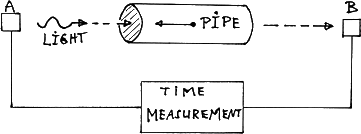 Figure 2-2-VII
A light wave going through a pipe may adjust itself to the gravity field of the pipe for the time the light wave is in the pipe. Let light go from left to right through a very small tunnel in an almost massive lead pipe as in Fig.2-2-VII (or some other heavy material; the experiment has to be done in vacuum).
When the pipe is moved to the left one may measure time differences (compared to the situation in Fig.2-2-VII with the pipe standing still or moving to the right) if light waves adjust themselves in the pipe to the gravity field of the pipe. If in Fig. 2-2-VII:
LAB = distance between A and B = 30 m Lpipe = the length of the pipe = 3 m vpipe = velocity of the pipe moving to the left = 300 m/s c = velocity of light relative to the gravity field it is in = 300,000 km/s = 300,000,000 m/s Then the time the light needs to travel from A to B with the pipe standing still is: tB - tA = LAB/c = 1 x 10-7 s And the time the light needs to travel from A to B with the pipe moving to the left is: tB - tA = (LAB - Lpipe)/c + Lpipe/(c - vpipe) + [(Lpipe/c) x vpipe]/c = (1 x 10-7 + 2 x 10-14) s Thus time differences in the order of 10-14 s have to be measured in an experiment with the above mentioned lengths and velocities.
[May 2003: Measuring time differences up to 10-18 has become possible lately17. End May 2003]
The distance the light wave travelled to go from A to B in the case the pipe did not move to the left was:
LAB = 30 m The distance the light wave travelled to go from A to B in the case the pipe moved to the left was: LAB + [(Lpipe/c) x vpipe] = (30 + 3 x 10-6) m If no direct time measurements are possible then perhaps interference experiments with two beams of light, one beam being influenced as above with a pipe, may bring evidence about whether or whether not light adjusts itself to the gravity field it is in. If one puts a wavelength measuring instrument in the (right end of the) pipe one may also measure blueshift when the pipe moves to the left.
Something else: An experiment may be done to prove that when the light source is on Earth there is no such thing as aberration: a beam of light from an artificial light source that passes through very small holes in a number of plates standing behind each other (Fig.2-2-VIIIa and 2-2-VIIIb) may or may not be blocked 12 hours later (Fig.2-2-VIIIc) because of deviation by the velocity of the Earth.
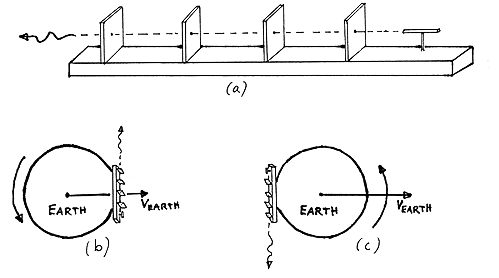 Figure 2-2-VIII
Verification of Bradley's explanation of stellar aberration. [May 2003: A professor of a General Relativity Group in the UK made it clear to me that the experiment as shown in Fig. 2-2-VIII won't lead to any experimental evidence unless you have an experiment with a light source with different light waves as in Fig. 2-2-VIII*. Right from the source different wavelengths have to depart in order to be able to measure whether Bradley's explanation of stellar aberration is right or wrong.
 Figure 2-2-VIII*
Verification of Bradley's explanation of stellar aberration has to be done with a certain type of light source. End May 2003] According to the theory of relativity there are no deviations because the light source is travelling at 30 km/s too. But if no deviations are found because light is caught in the gravity field of the Earth then light waves from stars are dragged along with the Earth as well.
Saying that the light source is travelling at 30 km/s too in Fig. 2-2-VIII is the only escape route for people who still want to cling to the theory of relativity when future experiments point out that there are no deviations to be found with the experiment of Fig. 2-2-VIII (with a source like in Fig. 2-2-VIII*). But if so then the light coming from the light source in Fig. 2-2-VIIIb/VIIIc is moving faster than the velocity of light c for an observer on the Sun). It would mean that the velocity of light from stars depends on the (direction of the) velocity of the stars. It would mean that there is overtaking of light by light in empty space. It may be very difficult to prove experimentally (with Fig. 2-2-VIII/VIII* or another experiment) whether light goes from B to A in Fig. 2-2-I or from B to C meanwhile the telescope moving from A to C.
Perhaps the following (see Fig. 2-2-IX) may confirm the gravity-is-the-ether hypothesis.
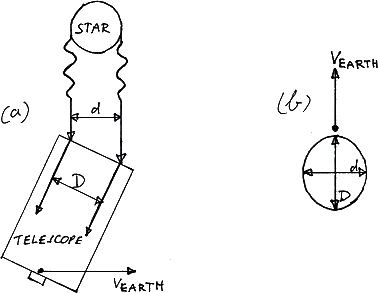 Figure 2-2-IX
If Bradley's explanation of stellar aberration is correct then the diameter of a star appears to enlarge a little in the direction the Earth moves in its orbit. If the light goes from B to C in Fig. 2-2-I meanwhile the telescope moving from A to C then the original diameter (d in Fig. 2-2-IX) of a star is seen a little larger (by the observer behind the telescope, see Fig. 2-2-IXb) in the direction the Earth moves in its orbit: d becomes D. With simple geometry it can be shown that (see Fig. 2-2-IXa):
D/d = (c2 + VEarth2)½/c With c = 300,000 km/s and VEarth = 30 km/s one gets: D = 1.000000005 x d If on the other hand the light goes from B to A in Fig.2-2-I then we may be dealing with the crash in/double drag effect (see Fig. 2-2-Xa). 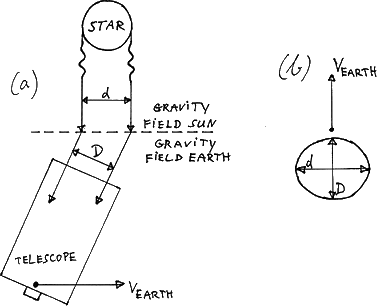 Figure 2-2-X
If there is a crash in/double drag effect then the diameter of a star appears to shrink a little in the direction the Earth moves in its orbit. Now perhaps the original star diameter (d) gets seen a little smaller (D in Fig. 2-2-Xb) in the direction the Earth moves in its orbit. With simple geometry it can be shown that (see Fig. 2-2-Xa):
D/d = c/(c2 + VEarth2)½ Which brings: D = 0.999999995 x d Perhaps this effect can be measured (with or without interferometers that can measure the diameters of stars). See 3-1 for more experiments that may confirm the gravity is the ether hypothesis in the future.
[February 2004: In 2-1 I describe how in 18th and 19th century scientists expected photons from a certain star to have different velocities depending on the velocity of the Earth relative to that star. Perhaps one day certain (high energy) cosmic rays will be found from a particular source in the Universe or our Galaxy. Measuring the velocity of such rays (i.e. atoms/ions/electrons) with the Earth having different velocities relative to the cosmic ray source may explain something about photons too, i.e. when it is measured that very high energy cosmic rays (for instance very fast protons or very fast electrons) adjust their velocity to the velocity of the Earth orbiting the Sun (as suggested with photons in 2-1) then this measurement may be a strong hint that photons may act the same way (i.e. then photons too may adjust their velocity to the velocity of the Earth). End February 2004] |